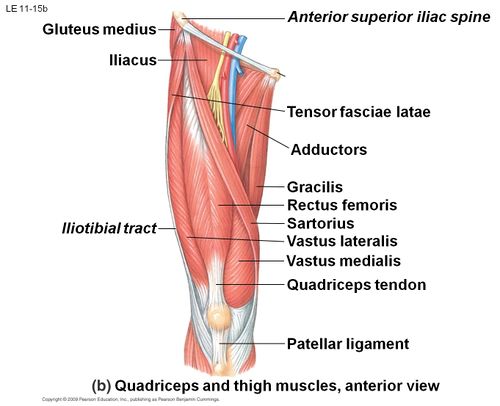Knee Extension Resistance Test: Difference between revisions
No edit summary |
Kim Jackson (talk | contribs) m (Text replacement - "[[Muscle Strength" to "[[Muscle Strength Testing") |
||
| (3 intermediate revisions by one other user not shown) | |||
| Line 1: | Line 1: | ||
<div class="editorbox"> | <div class="editorbox"> | ||
'''Original Editors '''- [[User:Yelena Gesthuizen|Yelena Gesthuizen]] | '''Original Editors '''- [[User:Yelena Gesthuizen|Yelena Gesthuizen]] | ||
| Line 10: | Line 8: | ||
== Purpose == | == Purpose == | ||
[[File:Quadriceps muscle.jpg|right|frameless|500x500px]]The extension resistance test is used to perform a maximal provocation on the muscle-tendon mechanism of the extensor muscles ([[Quadriceps Muscle|Quadriceps femoris]]). | [[File:Quadriceps muscle.jpg|right|frameless|500x500px]]The extension resistance test is used to perform a maximal provocation on the muscle-tendon mechanism of the extensor muscles ([[Quadriceps Muscle|Quadriceps femoris]]). | ||
* Is a [[Muscle Strength|manual muscle test]] for strengths of grade 3 to 5, not applicable for lesser grade. | * Is a [[Muscle Strength Testing|manual muscle test]] for strengths of grade 3 to 5, not applicable for lesser grade. | ||
* The extension resistance test is positive when the affected knee shows less power to hold the pressure. If positive we can say the extensor mechanism of the knee is disturbed.<ref name="Hagen">Hagen, K., ‘Anterieure Kniepijn’, Afstudeeropdracht fysiotherapie HvU, 2005, p. 1-8. (Level of Evidence 2A)</ref> | * The extension resistance test is positive when the affected knee shows less power to hold the pressure. If positive we can say the extensor mechanism of the knee is disturbed.<ref name="Hagen">Hagen, K., ‘Anterieure Kniepijn’, Afstudeeropdracht fysiotherapie HvU, 2005, p. 1-8. (Level of Evidence 2A)</ref> | ||
Latest revision as of 14:27, 12 April 2021
Original Editors - Yelena Gesthuizen
Top Contributors - Laura Ritchie, Lucinda hampton, Admin, Yelena Gesthuizen, Kim Jackson, Evan Thomas, WikiSysop and Wanda van Niekerk
Purpose[edit | edit source]
The extension resistance test is used to perform a maximal provocation on the muscle-tendon mechanism of the extensor muscles (Quadriceps femoris).
- Is a manual muscle test for strengths of grade 3 to 5, not applicable for lesser grade.
- The extension resistance test is positive when the affected knee shows less power to hold the pressure. If positive we can say the extensor mechanism of the knee is disturbed.[1]
Technique[edit | edit source]
Knee Extension ( tests grade 3-thru 5)
1. Ask patient to sit up straight and support trunk with arms propped with no greater
than 20 degree of trunk extension. 2. The therapist may put their hand or a rolled towel
under the distal end of the thigh to cushion it.
3. Ask patient to extend the knee.
4. Place the knee in 20° of flexion from full extension to avoid mechanical locking of the
joint.
5. Apply resistance just proximal to the ankle.
NB. For a grade of 3 the patient should be able to actively extend the knee from 90o of flexion without a swinging motion secondary to flexing the knee and creating momentum[2]. This test is not appropriate for a grades 0-2.
In the video (R), resisted testing of knee starts at 4m30s.
References[edit | edit source]
- ↑ Hagen, K., ‘Anterieure Kniepijn’, Afstudeeropdracht fysiotherapie HvU, 2005, p. 1-8. (Level of Evidence 2A)
- ↑ kumc.ed MANUAL MUSCLE TESTING (MMT) Available from:http://www.kumc.edu/Documents/fshd/ManualMuscleTesting.pdf (last accessed 3.9.2020)







